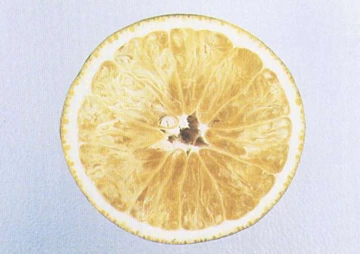Sweet oranges (Citrus x sinensis (L.) Osbeck ) (Fig. 1) are the most popular citrus variety in the world and are mainly commercially harvested for juice – 75% − rather than for fresh eating − 25%. There is nothing quite like peeling and eating a fruit from one’s own orange tree on a cool winter morning in the desert or enjoying a fresh-squeezed glass of orange juice that is far better than anything one can purchase at the supermarket. Sour oranges (Citrus x aurantium) and their subspecies are most often used as ornamental trees since their fruit are not often eaten fresh due to extreme bitterness. Sour orange oil is found in perfume and its peel is the preferred ingredient in marmalade. Whether you prefer sweet oranges or sour ones, choosing the proper variety is the most important first step.
Both sweet and sour oranges are complex naturally occurring hybrids of mandarins and pummelos (a large fruit that is also an ancestor of grapefruit) that originated in Southeast Asia, southern China and Eastern India thousands of years ago.1 Over the centuries, oranges have naturally mutated into hundreds of varieties which farmers have selected and propagated. However, only a few varieties are available at a local retail nursery. Descriptions of the most commonly available sweet and sour orange varieties available from retail nurseries in Arizona (plus a few extra of interest to the author) and their characteristics are found below. These descriptions are specific for the Arizona desert and may be slightly different than those found in other publications. The descriptions do not include those for “mandarin oranges”, which are more properly called mandarins and will be described in a subsequent publication.
Jump To:
- Growing oranges
- Sweet Oranges
- Navel Oranges
- Washington (Parent Washington)
- Atwood
- Bahianinha
- Cara Cara
- Chet Hoel
- Don Shaw
- Fisher
- Fukumoto
- Lane Late
- Newhall
- Robertson
- Sweet or Common Oranges
- Diller
- Hamlin
- Macetera
- Marrs
- Pineapple
- Salustiana
- Trovita
- Valencia Oranges
- Campbell
- Delta
- Midknight
- Olinda
- Blood Oranges
- Moro
- Ruby
- Sanguinelli
- Smith Red
- Tarocco
- Acidless Oranges
- Vainiglia Sanguigno
- Sour Oranges
- Seville
- Bergamot
- Bouquet de Fleurs
- Chinotto
- References
Growing oranges
Rootstock
All oranges other than sour orange trees are grown on a rootstock. A rootstock is another citrus variety that the orange tree is grafted to in the nursery. Orange trees are grafted to rootstocks because the rootstock generally improves growth, fruit quality or disease resistance of the tree. If you look carefully at the trunk, you will often see an area where the bark changes texture or where the trunk increases in circumference. Below that area is the rootstock and above it is the orange tree.
Choosing the proper rootstock is vital when growing oranges in the desert, but it is often difficult to know which one is used. Sometimes the rootstock name is found on a tag tied to the branch or wrapped around the trunk. Occasionally it is found on a sticker on the pot. The best rootstocks for oranges in Arizona (in no particular order) are as follows: Sour orange, Smooth Flat Seville, Carrizo Citrange and C-35 Citrange. Flying Dragon (a dwarfing rootstock) and Trifoliate orange seem to be more suitable in heavy clay or silt soil, rather than in sandy or gravelly soils unless amended with organic matter. The author does not recommend purchasing orange trees on Volkameriana or Macrophylla rootstocks, as these will produce vigorous trees but with serious problems with granulation (see below).
Pollination
Navel oranges and ‘Valencia’ oranges can set fruit without the need for pollination. This may be true of other orange varieties as well. Therefore, it is not necessary to plant two varieties of orange. However, even if pollination was needed, there are usually many varieties of citrus in a neighborhood that would provide pollen if needed.
Fruit drop
Navel oranges, and to a lesser extent early maturing sweet oranges are known to drop flowers and fruit when under heat stress in the spring. Temperatures in the 90’s (F) or greater during bloom or fruit set will lead to excessive fruit drop leading to an unacceptable reduction in the final crop. While there is no way to eliminate this problem entirely, adequate irrigation is key. Sufficient irrigation will reduce the degree of fruit drop while insufficient irrigation in the spring will make it worse.
Granulation
Fruit coloration and harvest
The exterior color of an orange does not necessarily indicate interior maturity, particularly when the fall is warmer than normal. Oranges turn color from green to orange because of biochemical reactions that are triggered by temperature. The sooner it becomes cool, the sooner the color change from green to orange. But the change from sour to sweet in the interior of the fruit is determined by heat. The more heat in the fall, the quicker the acids in the fruit are reduced and the sugars increased. Therefore, when the fall is warmer than usual the fruit might have a greenish exterior but be perfectly ready to eat. The best way to tell if an orange is ripe is to taste it!
Uses
In addition to eating fresh or juicing, oranges can be used in many ways.
- Make marmalade. Use sour oranges for traditional marmalade (Fig. 19) or sweet oranges if preferred. Oranges can be made into orange curd and spread on toast.
- Zest the orange peel. Zest can be used fresh or frozen for later use. Freeze the zest with water in ice cube trays for later. Zest can also be dried and powdered.
- Make candied orange peels or orange slices. These will store for a long time and can be used in baking. They are wonderful when dipped in dark chocolate.
- Make an orange pomander using cloves (Fig. 20). These can be used to scent cloves or linens.
- Place orange peels and herbs in extra virgin olive oil. Place the oil in a dark place and after a few weeks it will be infused with orange oil. Blood oranges are good for this.
- Make orange sugar with fresh orange peel twists combined with white sugar.
- Make orange infused vinegar or mix orange juice with vinegar for a vinaigrette.
- Infuse oranges into honey.
- Soak oranges in grain alcohol or vodka for several weeks. You will have homemade Orangecello.
- Consider grilling orange slices. And then serving them on ice cream.
- Fresh orange juice is a great marinade for pork.
- Consider using oranges in a salsa.
- Orange slices are great in a green salad.
- Orange juice can add to or replace lime juice in ceviche.
- Salted oranges can also be used to clean surfaces, dried peels can be made into a facial mask, and dried peels can also be used as kindling to start a fire. The use of oranges is only limited by one’s imagination!
Sweet Oranges
Sweet orange varieties can be categorized into five groups − navel, sweet (Common), ‘Valencia’, blood and acidless. In Arizona, there is always an orange variety that is ready to eat from late October through late May. Early maturing oranges often have fully colored interiors and are sweet enough to eat before they have full exterior color, particularly if the fall is warmer than usual. Late in the season, some oranges may become insipid, while other late-maturing varieties will lose their exterior orange color and revert to green due to springtime heat. It always is best to taste an orange to determine if it is ready to eat rather than relying on exterior color.
The navel orange variety originated as a naturally occurring mutation of a sweet orange. Navel oranges develop a rudimentary secondary fruit at the base of the primary fruit, opposite the stem end, which is enveloped within the peel. This mutation also causes the fruit to become seedless because the trees have no functional pollen and few viable ovules2. Navel oranges need no pollen to set fruit (See the “Special Considerations…” section below).
Navel oranges are favorites for eating fresh because they are usually seedless and relatively easy to peel. They can be juiced, but the juice should be consumed directly because most navel orange juice contains bitter compounds including limonin, which make stored juice disagreeable. A drawback of growing most navel orange trees in Arizona is their sensitivity to heat. The tree will normally drop many of the small fruits in late spring, and this problem is made worse if the tree is under water stress or if the temperatures during bloom or fruit set in April and May are abnormally hot.
Navel orange fruit, especially the late-harvested selections, also will become dry or granulated if planted on a vigorous rootstock, such as Citrus macrophylla or Citrus volkameriana. Granulation can also be a problem if navel orange trees are fertilized with too much nitrogen especially late in the season. Granulation is worse where there are sandy or gravelly soils. It is always better to complete all fertilization of navel oranges before July 1st if granulation is a problem. In Southern Arizona, both quality and quantity of navel orange fruit can disappoint unless the tree is cared for properly.
Washington (Parent Washington)
Navel oranges were well known in the Mediterranean basin as early as 1646. Portuguese sailors introduced the variety to Northeast Brazil, where it became known as the ‘Bahia’. Twelve ‘Bahia’ seedlings were shipped to the USDA in Washington DC in 1870, and two of them were transferred on to Riverside, CA in 1871. One of those original trees still grows in Riverside today. Due to the fine quality and appearance of the fruit, they were soon renamed ‘Washington’ and extensively propagated. Thus, ‘Washington’ was the first navel grown extensively in the U.S. and is often known as ‘Parent Washington’ (Fig. 2). Today, this is still the most popular navel orange grown in Arizona and virtually all of the old navel orange orchards that still exist in Central Arizona are ‘Washington’. If you purchase a navel orange without any additional identification, it is almost certainly a ‘Washington’. This mid-season navel variety produces a medium-sized tree of medium vigor with large fruit of good quality. Fruit are ready for harvest beginning in early December and will last through March.
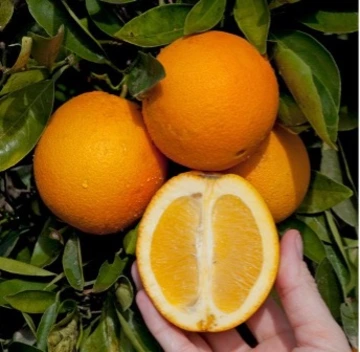
Figure 2. ‘Parent Washington’ Navel orange
Toni Siebert and David Karp, University of California-Riverside Citrus Variety Collection
Atwood
‘Atwood’ originated as a naturally occurring mutation of ‘Washington’ in 1935 and is very similar to the parent variety. It gained attention because it matures slightly earlier and its rind is smoother than ‘Washington’, and it stores well on the tree. Early-season fruit quality, however, is not quite as good as ‘Washington’, meaning that it will be slightly less sweet3. It has been extensively planted in California.
Bahianinha
This selection of navel orange is new to the United States but is well-known in Brazil where it originated as a bud sport (spontaneous mutation) of the ‘Bahia’ in 1907. Reports indicate that it is smaller and less vigorous than the ‘Bahia’, but more productive4 and less likely to produce overly large fruit. Also, it is said to mature one to two weeks earlier than ‘Bahia’ and better adapted to hotter climates because it produces more consistently. Finally, ‘Bahianinha’ is known in Brazil to have a richer and sweeter flavor than ‘Bahia’, a fact that the author can confirm, based on limited consumption. Currently there are just a few bearing trees at the University of Arizona in Yuma, but the selection is being propagated.
Cara Cara
‘Cara Cara’ (Fig. 3) is the only red-fleshed navel selection available. It originated in Venezuela as a mutation of ‘Washington’ in 1976 and was introduced to the US in 19875. ‘Cara Cara’ shows off crimson flesh similar to red grapefruit, while the flavor and exterior peel color are similar to other navel orange varieties.
The interior color is due to the presence of the antioxidant lycopene. Lycopene, unlike the anthocyanin pigments found in blood oranges, requires little chill for color formation. There will never be a problem with ‘Cara Cara’ coloration in the desert.
The flavor of the ‘Cara Cara’ is more complex than a regular navel, with a hint of cranberry or blackberry flavor. Acidity of the fruit is slightly lower than a regular navel orange, while the flesh can be slightly firmer. The fruit has little or no exterior blush that might indicate its interior color. Fruit size is similar to ‘Washington’. The ‘Cara Cara’ has become quite desirable in the supermarket which has likely increased its popularity in the garden. ‘Cara Cara’ is a mid-season navel with tree characteristics similar to that of ‘Washington’, except that occasional leaf variegation may occur. Harvest time begins in early to mid-December, similar to ‘Washington’.

Figure 3. 'Cara Cara' navel orange.
Toni Siebert and David Karp, University of California-Riverside Citrus Variety Collection
Chet Hoel
‘Chet Hoel’, a local navel selection, originated as a bud sport of ‘Washington’ in Mesa, Arizona in the early half of the 1900’s. It is named after one of the founders of Consolidated Citrus Growers, a citrus growing, packaging and shipping business. ‘Chet Hoel’ is similar to ‘Washington’ in tree size and harvest time. However, reports indicate that it has lower acidity and peels easier than ‘Washington’6.
Don Shaw
The ‘Don Shaw’ navel orange is another local selection that originated as a natural mutation of ‘Washington’ near Mesa, AZ and is named after a local citrus grower. According to reports, the tree size of this selection is smaller than ‘Washington’ it holds fruit well later into the spring and when juiced, the flavor is less bitter7.
Fisher
‘Fisher’ originated as a naturally occurring mutation of ‘Washington’8. This selection gained attention because it becomes sweet earlier than ‘Washington’, but it does not color earlier. Tree characteristics are similar to ‘Washington’. In navel orange trials conducted at Yuma and Phoenix, ‘Fisher’ had the greatest yield.
Fukumoto
‘Fukumoto’ (Fig. 4) is another early-season navel orange that originated in southern Japan. This variety attracted attention in the marketplace because of its excellent fruit size and red-orange color9 and that it can be harvested starting in late October or early November, three to four weeks ahead of ‘Washington’. Similar to ‘Fisher’, it may not have full orange peel color at harvest, although it is ready to eat. ‘Fukumoto’ is recommended only on Sour Orange rootstock in Arizona because recent test trials show evidence of rootstock incompatibility with Carrizo rootstock. ‘Fukumoto’ trees are smaller than those of ‘Washington’, and may occasionally produce variegated leaves or fruits that have distinctive coloration (chimeras).
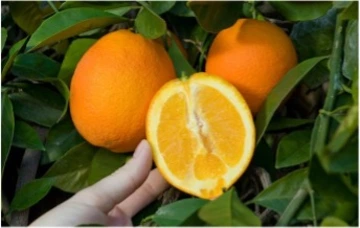
Figure 4. 'Fukumoto' navel orange.
Toni Siebert and David Karp, University of California-Riverside Citrus Variety Collection
Lane Late
‘Lane Late’ was the first of many late-season navels originating as bud sports of ‘Washington’ in Australia. Although these are often called summer navels, they can be harvested beginning in January in the low desert and may be harvested through April. Fruit granulation can be a problem with ‘Lane Late’. There are approximately thirteen different varieties of late navels with the ‘Lane Late’ being one of the most promising in Arizona trials. Other varieties include the Australian selections ‘Autumn Gold’, ‘Barnsfield’, ‘Chislett’, and ‘Powell’ and the Spanish selection ‘Navelate’. Tree characteristics are indistinguishable from ‘Washington’.
Newhall
‘Newhall’ is an early-maturing selection from California that originated as a bud sport of ‘Washington’10. This selection can be harvested as early as late October and has a deeper rind and flesh color than fruit of ‘Washington’, but the trees are less vigorous with darker leaves11. Other tree characteristics are similar to ‘Washington’.
Robertson
This selection, like all the other navel oranges, originated as a spontaneous mutation of ‘Washington’. ‘Robertson’ was discovered in California in 1925 and distinguishes itself because the tree lacks vigor (dwarfing) and is heat-resistant, precocious and very prolific12. Fruit mature 10 days to two weeks before ’Washington’, but are slightly smaller. Fruit flavor is similar to ‘Washington’.
Sweet or Common Oranges
Sweet oranges or “Arizona Sweets,” are terms commonly used to refer to a group of orange varieties that are harvested from early November through February in Arizona. The author recalls being told that the “Arizona Sweet” term appeared in the first half of the 20th century, Arizona growers produced several sweet orange selections, but they were indistinguishable from each other. Therefore, rather than selling them in boxes under their individual names, the packinghouse sold them all under the term “Arizona Sweet”. When trees in the nursery are identified only as ”Arizona Sweet“ they are usually either ‘Hamlin’, ‘Trovita’ or ‘Salustiana’.
Unlike navel oranges, sweet oranges are versatile, they are good for both juicing and eating fresh. Unlike navel oranges, sweet oranges can be seedy, and do not have the secondary fruit. Sweet oranges are not as easy to peel as navel oranges but peel easier than ‘Valencia’ oranges. Most sweet oranges mature earlier than ‘Valencia’ oranges. Early maturing sweet oranges may develop granulation, especially in those years when it is especially hot in the fall, when fertilized with too much nitrogen, or when grown on sandy soils. Tree characteristics of sweet oranges are similar to those of navel oranges.
Diller
‘Diller’ originated in Phoenix, Arizona in 1910, and is a small to medium fruit with comparatively few seeds13,14. This variety is notable due to its productivity and is excellent for juicing. Fruit are ripe from December until February and are slightly smaller than fruit of other sweet oranges. ‘Diller’ fruit retain some “tartness”.
Hamlin
‘Hamlin’ (Fig. 5) sometimes known as ‘Early Hamlin’, is an early-season orange that originated as a chance seedling in Florida in 187915. This variety, along with ‘Valencia’ is used for processing into juice in Florida. ‘Hamlin’ trees are of average size, and the fruit is medium to small with zero to six seeds per fruit. ‘Hamlin’ ripens as early as November and will hold on the tree until February. Because of this, the fruit may often be mature before any damaging frost. The peel is smooth and pale orange and juice is pale orange as well. ‘Hamlin’ flavor is not as acidic when mature compared with other sweet oranges listed here. ‘Hamlin’ performs well in the low desert.
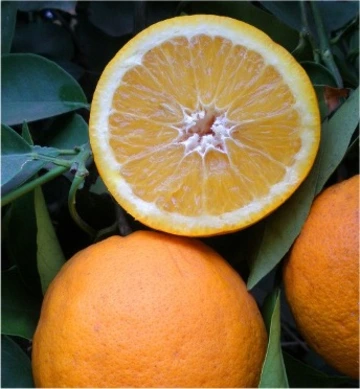
Figure 5. 'Hamlin' sweet orange.
Toni Siebert and David Karp, University of California-Riverside Citrus Variety Collection
Macetera
Macetera’ is an old Spanish selection16. Trees are large and the selection has regular high yields once mature. Fruit are late-maturing for a sweet orange, bearing from January until the end of April, similar to a ‘Valencia’. However, the peel is thin and may be easily removed unlike a ‘Valencia’. Because of its thin peel and late maturity, ‘Macetera’ fruit are sensitive to frost. The juice content of the fruit is high, seediness is moderate, and the flavor and fragrance are unique.
Marrs
‘Marrs’, also known as ‘Marrs Early’, is another early-season, sweet orange that originated in 1927 in Texas as a bud mutation of a navel orange tree17. However, ‘Marrs’ fruit do not have a navel. Trees are compact but moderately vigorous, precocious and prolific. The fruit is medium to large in size and has seven to ten seeds per fruit. Fruit reach edibility, because they are low acid, in late October but they are best when allowed to remain on the tree for at least 2 to 4 more weeks. Fruits have thin light orange peels and seven to ten seeds each. ‘Marrs’ fruit will become insipid if left on the tree too long.
Pineapple
This selection originated as a seedling in Florida in 1860, probably from fruit brought to Charleston, South Carolina from China18. ‘Pineapple’ orange trees are medium to large-sized and very productive, although they tend to bear in alternate years. ‘Pineapple’ trees are also susceptible to pre-harvest fruit drop. Fruit that remain will ripen mid-season, from December until February, and for that reason, are susceptible to frost. Pineapple produces medium-sized oranges with fifteen to twenty-five seeds per fruit (Fig. 6). Juice content is high, with a fine, rich flavor and excellent color. Until recently, ‘Pineapple’ was the chief mid-season processing orange in Florida. The variety was named Pineapple because of the fragrance and flavor of the fruit.
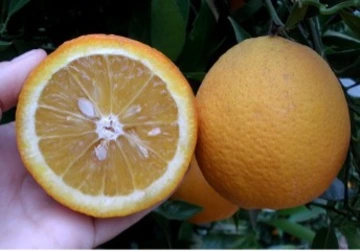
Figure 6. 'Pineapple' sweet orange.
Toni Siebert and David Karp, University of California-Riverside Citrus Variety Collection
Salustiana
The ‘Salustiana’ orange originated as a bud mutation from another sweet orange in Spain in 1950. This variety is not planted commercially in the United States but is commonly planted in Mexico19. ‘Salustiana’ trees are vigorous and productive20. Fruit are mid-season, ripe from December until February or March and are virtually seedless. Fruit size is medium to large. The flesh has a fine, rich, sweet flavor, and is melting, meaning that it softens rapidly in the mouth when eaten.
Trovita
‘Trovita’ is another high-quality sweet orange that originated as a seedling from a fallen ‘Washington’ navel orange fruit in California in 191621. The tree is vigorous and upright with a slight tendency to alternate bear22. This variety is considered to be heat tolerant and productive under desert conditions. Compared with ‘Washington’, the fruit is smaller, juicier, and of milder flavor. ‘Trovita’ fruit do not have a navel and their juice will not become bitter.
Valencia Oranges
‘Valencia’ oranges are the leading citrus variety in many citrus-producing countries around the world. Although they can be eaten fresh, ‘Valencia’ oranges are most often processed because of their excellent quality juice which has a deep orange color, high sugar content and an unparalleled richness of flavor. This is the primary fruit processed in Florida for juice.
While the name would suggest that the origin of the ‘Valencia’ is the eponymous Spanish city, in reality the origin is likely China, where several similar selections exist23. One of these selections was likely taken to Portugal and then to the Azores where it was first mentioned24. From the Azores, it can be traced to England in 1865 where it was named ‘Excelsior’ and it travelled onward to the United States. The variety was first planted in California in 1876 and was likely established in Arizona soon thereafter.
‘Valencia’ fruit have a high heat requirement for maturation. In the desert, that requirement is met just a few weeks before bloom; there are about 11 months from bloom to maturity. In cooler, coastal areas, the requirement may not be met until 14 to 18 months after bloom. Therefore, the typical ‘Valencia’ fruit from the desert garden will be harvestable in February, whereas the ‘Valencia’ fruit in the supermarket, which comes from cooler areas of California, will not be available until June after the earlier-maturing navel oranges have been harvested. ‘Valencia’ fruit also hold well on the tree and can be harvested into May or June in the desert. ‘Valencia’ fruit become sweeter later into the harvest season, and the fruit has a lower level of bitter compounds at harvest compared with navel oranges25. In the latter part of the season, the orange color of the peel will degrade, and the green color will reappear, a condition known as “regreening.” However, the flesh does not quickly lose its color or flavor even when the exterior is green. ‘Valencia’ fruit is medium in size with few seeds, typically zero to six. ‘Valencia’ is a welcome orange that can be picked from the tree in the late spring and early summer when all the others are no longer available.
There are several selections of ‘Valencia’ oranges that have been noteworthy enough to have been given separate names. A ‘Valencia’ tree purchased at the nursery without additional identification is likely one of these noted below. All of them perform well in the desert.
Campbell
‘Campbell’ is often called a ‘Valencia’ because its fruit is indistinguishable from that selection, however it was planted as a seedling in 1871, five years before the introduction of ‘Valencia’ to California26. This selection is purportedly vigorous and a little slower to come into bearing than a ‘Valencia’ and may regreen faster in the desert.
Delta
This selection, also known as ‘Delta Seedless’ was discovered in South Africa in 195227. Trees of ‘Delta’ are vigorous and slightly more erect than other ‘Valencia’ selections. Fruit can be slightly elongated, and generally have no seeds, but occasionally as many as two (Fig. 7). Sugar levels are slightly lower than other ‘Valencia’ oranges, but acid levels drop early, meaning that the ‘Delta’ can be picked two weeks earlier than other ‘Valencia’ fruit.
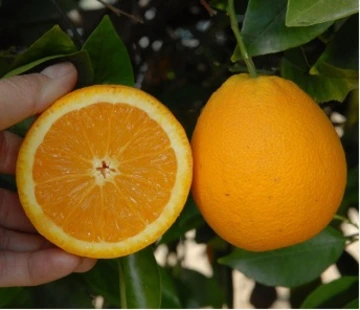
Figure 7. 'Delta Valencia’ orange.
Toni Siebert and David Karp, University of California-Riverside Citrus Variety Collection
Midknight
‘Midknight’ was first selected in South Africa about 192728. Trees of ‘Midknight’ are slower growing than other ‘Valencia’ selections, but with similar yields once mature. Fruit are seedless, round and somewhat larger than other ‘Valencia’ oranges, with a smooth but difficult-to-remove peel (Fig. 8). Juice content is high as is the sugar level. ‘Midknight’ is generally considered to be a high quality ‘Valencia’.
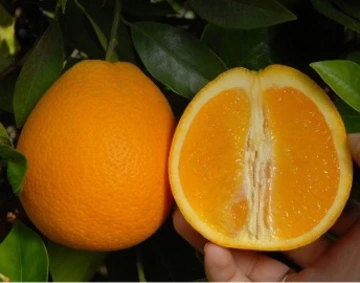
Figure 8. 'Midknight Valencia' orange.
Toni Siebert and David Karp, University of California-Riverside Citrus Variety Collection
Olinda
‘Olinda’ was found as a chance seedling in California in 193929. Tree and fruit of this selection are indistinguishable from other ‘Valencia’ selections. ‘Olinda’ is the most common ‘Valencia’ grown commercially in Arizona.29. Tree and fruit of this selection are indistinguishable from other ‘Valencia’ selections. ‘Olinda’ is the most common ‘Valencia’ grown commercially in Arizona.
Blood Oranges
These oranges are characterized by the dark red color that develops internally and sometimes externally, hence the common name “blood orange”. The pigmentation is caused by anthocyanin pigments, rather than the red or pink lycopene pigments found in the ‘Cara Cara’ navel orange and in grapefruit. Expression of the anthocyanin is regulated by genes that are induced by cold temperatures30.
In Arizona, blood orange color develops best after a hot dry summer followed by a cold winter. Coloration may be slight in December, but as the winter progresses, color will usually increase. Maximum pigmentation will appear by February. However, in the warmer areas of the Sonoran Desert many blood oranges fail to achieve this typical color every year because there is not sufficient cold. Blood oranges grown in cooler-winter areas of the state such as Tucson will have the most coloration, while those grown in warmer-winter areas such as Yuma will have the least. Fruit exposed to the sun will have more interior color than those in the shady part of the tree, and appearance of red color on the peel is no guarantee of red color inside.
Moro
‘Moro’ (Fig. 9) is of Sicilian origin, but it is unclear exactly how it arrived in the United States31. The tree is moderately vigorous and spreading. The fruit is moderately-sized, round and borne in clusters. The peel is blushed red and slightly pebbly. When there is sufficient cold, the interior color is strong, almost violet, and even in the warmest areas of the state, there is typically some color. ‘Moro’ begins to show color in December and January with full coloration by February. ‘Moro’ fruit always have some “tartness”. ‘Moro’ juice is deep burgundy and is often served for breakfast in Italian cafes. This selection is the one most commonly found in the supermarket because its exterior color appeals to the eye.
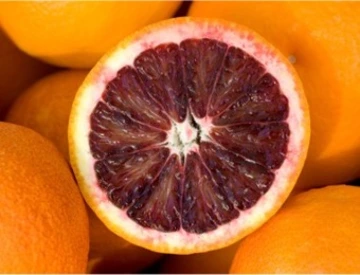
Figure 9. 'Moro' blood orange.
Toni Siebert and David Karp, University of California-Riverside Citrus Variety Collection
Ruby
This selection was introduced from an unknown Mediterranean country to Florida about 1880 and was subsequently brought to California and Arizona32. Its color development is rather inconsistent but is purportedly better in the desert than on the coast. Flesh is streaked with color. ‘Ruby’ flesh is tender and juicy, and the flavor is rich.
Sanguinelli
‘Sanguinelli’ (Fig. 10) originated as a bud sport of ‘Doblefina’ blood orange in Spain in 195033. The tree is small to medium in size, very productive and thornless. The fruit peel is smooth and highly colored. ‘Sanguinelli’ fruit have few seeds and are oval and medium sized but can be smaller if the crop is heavy. Harvest time is a little later than most other blood oranges. Internal pigmentation is not as high as ‘Moro’, but still well-colored. The red pigment is concentrated adjacent to the segment walls.
‘Sanguinelli flesh is soft with a high juice content. The flavor is sweet with some tartness, but less than ‘Moro’.

Figure 10. 'Sanguinelli' blood orange.
Toni Siebert and David Karp, University of California-Riverside Citrus Variety Collection
Smith Red
‘Smith Red’ (Fig. 11) is a spontaneous mutation of a ‘Valencia’ orange that was “discovered” in 1988 in California34. Tree size and shape appears to be similar to other blood oranges. Fruit is slightly oval and larger than ‘Moro’ with a good peel blush and excellent interior color. Fruit have one to three seeds and the flesh is sweet and soft, though not as soft as ‘Tarocco’.
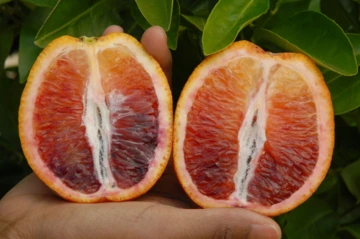
Figure 11. 'Smith Red' blood orange.
Toni Siebert and David Karp, University of California-Riverside Citrus Variety Collection
Tarocco
The ‘Tarocco’ (Fig. 12) is the finest quality blood orange from Italy. Trees are medium-sized, moderately vigorous and thorny35. Fruit are large with few seeds and may have a neck but have little exterior pigmentation. ‘Tarocco’ flesh is juicy and melts in the mouth and can be highly colored when the winter is cool. In warmer areas the flesh is speckled with red, often in a halo surrounding the core. The flavor is rich and fragrant with raspberry undertones and a nice balance between sweetness and acidity.
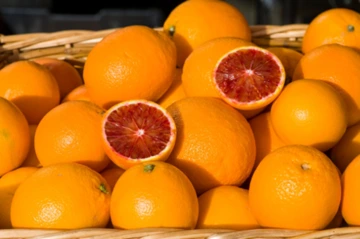
Figure 12. 'Tarocco' blood orange.
Toni Siebert and David Karp, University of California-Riverside Citrus Variety Collection
Acidless Oranges
Acidless oranges are not well-known in the United States, but are quite popular in Europe, North Africa and Brazil. They have extremely low acid levels. The author was unable to find any acidless varieties for sale in Arizona nurseries, but includes it in this publication in hopes of increasing interest in the selection.
Vainiglia Sanguigno
‘Vainiglia Sanguigno’ (Fig. 13) is an acidless orange that is pigmented with lycopene, similar to a ‘Cara Cara’ navel rather than with anthocyanin36. Trees of this selection are small and spreading. The fruit is medium sized with a smooth peel, and it will be seedy. The pink pigmentation is mostly found near the rind and near the segment walls. Juice content is high, and the flesh is sweet with no acidity.
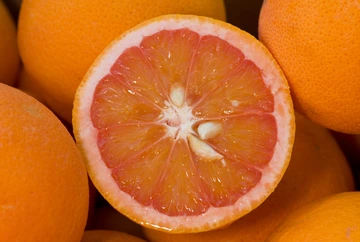
Figure 13. 'Vainiglia Sanguigno' acidless orange.
Toni Siebert and David Karp, University of California-Riverside Citrus Variety Collection
Sour Oranges
Also known as the bitter orange, the sour orange and its variants are primarily found in the landscape as ornamental trees rather than for consumption due to their unpalatable fruit. Sour oranges are also used as a rootstock, except where Citrus Tristeza Virus (CTV) is present, and for marmalade. Fruit of trees related to sour orange are sometimes candied or used for perfumes and rind oil.
Seville
The ‘Seville’ or common sour orange is often found as an ornamental tree in many southern Arizona cities (Fig. 14). Its origin is unclear, but it is heavily planted in southern Spain, and was certainly brought to the Western hemisphere by the Spaniards. ‘Seville’ differs from sweet oranges in several important ways. Trees are more upright and thornier, and resistant to cold, overwatering and neglect37. They are tolerant of Phytophthora root rot disease, but highly susceptible to CTV, which limits their use as a rootstock in California nurseries. The leaves are dark and pointed. The fruit is too sour to eat out of hand, but its rind and juice are the main ingredient in traditional orange marmalade. Three essential oils are made from the ‘Seville’ sour orange: Petitgrain essential oil from the leaves and twigs, Neroli essential oil from the flowers and bitter orange oil from the rinds. All are used in the perfume and cosmetic industry. Sour orange peels or oil are also used to produce liqueurs such as Cointreau™, Curaçao, Grand Marnier™ and Triple Sec.
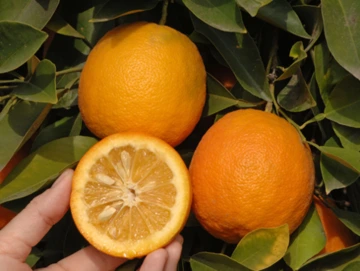
Figure 14. 'Seville' or standard sour orange.
Toni Siebert and David Karp, University of California-Riverside Citrus Variety Collection
Bergamot
Bergamot, Citrus x limon var. bergamia (Fig. 15) is likely a hybrid of a sour orange and a lemon38,39. First described in the 1750’s it probably originated in Italy. The tree is small to medium size, spreading and thornless. Bergamot fruit is yellow, highly aromatic and has a smooth, thin peel. Fruit shape is generally round but with a slight neck. The flesh is pale yellow and sour. Bergamot oil is used in eau de cologne, and to flavor Earl Grey tea.

Figure 15. Bergamot sour orange hybrid.
Toni Siebert and David Karp, University of California-Riverside Citrus Variety Collection
Bouquet de Fleurs
‘Bouquet de Fleurs’ (Fig. 16) is a sour orange selection that is primarily used as an ornamental, most often as a hedge40. Trees are small, spreading and thornless. Foliage is clustered and dense with small leaves.
‘Bouquet de Fleurs’ as the name suggests, flowers heavily.
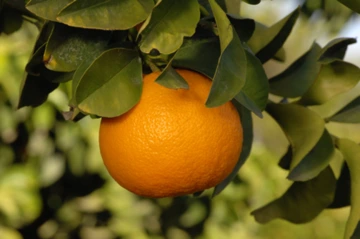
Figure 16. 'Bouquet de Fleurs' sour orange.
Toni Siebert and David Karp, University of California-Riverside Citrus Variety Collection
Chinotto
Chinotto (Fig. 17), or myrtle-leaf orange is presumed to be a mutation of the sour orange41. It is likely from China but gained notice in the Mediterranean region, particularly in Italy. The tree has low vigor and is slow growing. The internodes (space between the buds or leaves on a stem) is so short that the leaves are densely clustered and compact. The leaves are small and pointed, quite unlike any other citrus variety. The tree produces many flowers that develop into small orange fruit that hang on the tree, making this variety ideal as an ornamental tree. Chinotto fruit are used in Campari, an Italian aperitif, and in a unique Italian soft drink.
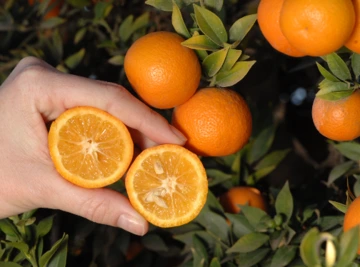
Figure 17. Chinotto orange.
Toni Siebert and David Karp, University of California-Riverside Citrus Variety Collection
References
- Wu, G., J. Terol, V. Ibanez, et al. 2018. Genomics of the origin and evolution of citrus. Nature 554: 311–316. https://doi.org/10.1038/nature25447.
- Hodgson, RW. 1967. Horticultural varieties of citrus, p. 477. In: W. Reuther, HJ. Webber and LD. Batchelor (eds.). The citrus industry volume 1. University of California Press, Berkeley, CA.
- Hodgson, Horticultural varieties, p. 479.
- Saunt, J. 2000. Citrus varieties of the world. Sinclair International Limited, Norwich, UK. p. 16.
- Saunt, Citrus varieties, p. 16.
- Babiarz, J., Phone call with the author, May 7, 2020.
- Shaw, D. Phone call with the author, June 9, 2020.
- Kahn, T. and G. Vidalakis. 2014. Scion cultivars, p. 70. In: L. Ferguson and E.E. Grafton Cardwell (eds). California citrus production manual. University of California Agriculture and Natural Resources Publication 3539.
- Saunt, Citrus varieties, p. 17.
- Hodgson, Horticultural varieties, p. 478.
- Kahn and Vidalakis, Scion cultivars, p. 71.
- Hodgson, Horticultural varieties, p. 482.
- Diller Sweet Orange, Citrus Variety Collection, accessed June 9, 2020. https://citrusvariety.ucr.edu/citrus/dillar.html
- Babiarz, J. Phone call with the author, May 7, 2020.
- Hodgson, Horticultural varieties, p. 445.
- Hodgson, Horticultural varieties, p. 447.
- Hodgson, Horticultural varieties, p. 448.
- Saunt, Citrus varieties, p. 28.
- Durón Noriega, LJ, BV. Gascón, JH Núñez Moreno and G. Martínez Diaz. 1999. Cítricos para el Noroeste de México. SAGAR p. 41.
- Saunt, Citrus varieties, p. 30.
- Hodgson, Horticultural varieties, p. 463.
- Saunt, Citrus varieties, p. 31.
- Lee, HA. and LB. Scott. 1920. Are Valencia oranges from China? Jour. Heredity 11(7):329-333.
- Hodgson, Horticultural varieties, p. 453.
- Hasegawa S. 1999. Limonin bitterness in citrus Juices. P. 89-106. In: Teranishi R., Wick E.L., Hornstein I. (eds) Flavor Chemistry. Springer, Boston, MA
- Hodgson, Horticultural varieties, p. 457.
- Kahn and Vidalakis, Scion cultivars, p. 74.
- Kahn and Vidalakis, Scion cultivars, p. 74
- Kahn and Vidalakis, Scion cultivars, p. 74
- Solved: The mystery of the blood orange, AAAS Eureka Alert, accessed June 10, 2020. https://www.eurekalert.org/pub_releases/2012-03/asop-stm031612.php
- Moro Blood Orange, Citrus Variety Collection, accessed June 10, 2020. https://citrusvariety.ucr.edu/citrus/moro.html
- Hodgson, Horticultural varieties, p. 473.
- Hodgson, Horticultural varieties, p. 474.
- Smith Red Blood Orange, Citrus Variety Collection, accessed June 10, 2020. https://citrusvariety.ucr.edu/ citrus/smithred.html
- Kahn and Vidalakis, Scion cultivars, p. 75
- Kahn and Vidalakis, Scion cultivars, p. 75.
- Hodgson, Horticultural varieties, p. 489.
- USDA, Agricultural Research Service, National Plant Germplasm System. 2020. Germplasm Resources Information Network (GRIN-Taxonomy).National Germplasm Resources Laboratory, Beltsville, Maryland. URL: Accessed June 30, 2020. https://npgsweb.ars-grin.gov/gringlobal/taxonomydetail.aspx?id=490141
- accessed June 11, 2020. https://citrusvariety.ucr.edu/citrus/bergamot.html
- Hodgson, Horticultural varieties, p. 491.
- Hodgson, Horticultural varieties, p. 494.


